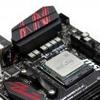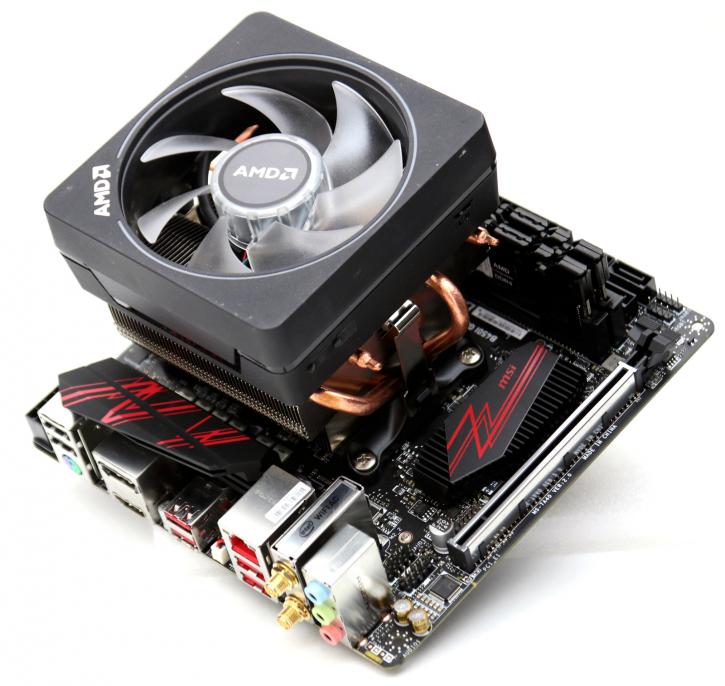Conclusion
Final Words
I always have a bit of a soft spot for small stuff that is loaded with features. With a motherboard sized 17x17cm you can build something incredibly small, but very powerful. And yes, I do like the MSI B450i Gaming PLUS AC very much. It' ticks the right boxes, offers pretty much anything it can at that form factor and being B450, it still remains to be a very affordable solution. Despite the small size, this board will offer most, if not all you need for a very decent Ryzen enabled PC. We had no problems whatsoever with the 8-core 2700X used, it ran great by defaults and also allowed for a good overclock as well. You can argue the 4+2 phase design, but when overclocked it simply did not overheat and neither do we think your average user will run Prime95 with FFTs in this spectrum of the market. So nothing on that front is worrying to me. This B450i Gaming PLUS AC is a bit more cut down of course, just one M2 slot, no thermal heatsink for that M2, just two DIMM slots limiting you to 32GB RAM as maximum and sure, you just get to fool around with one full x16 slot PCIe Gen3. Realistically though, how many people will run multiple graphics cards or multiple M2 SSD cards? As next to that one M2 slot (fully enabled x4 PCIe Gen3 btw), you still have up-to four SATA3 ports. Memory also was drop in, enable XMP and worked at 3200 CL14 kit after a restart, all good there. Tweaking wise, the motherboard will not be a serious limitation. Not all Zen+ processors will reach that 4.2~4.3 GHz domain though, but I do not see this motherboard to become the viable bottleneck. Our all-core 4200 MHz tweak was done by merely enabling a 42 multiplier, we left the rest at auto settings and sure, we had the XMP profile active. Do get some proper cooling though. Btw one remark here, I find the default FAN RPM settings to be rather extreme and thus loud for most coolers. That, however, is quite easily tweaked in the BIOS, of course.
Gaming performance
Previous Ryzen reviews have taught me that it is hard to convince a big part of the guru3d community and reader base that Ryzen is plenty fast for gaming. The new Zen+ processors and the respective platform overall bring a bit more oomph compared to last year's Ryzen. The fact remains, that if you take a Core i7 8700K it will still beat Ryzen in CPU bound gaming situations (low resolutions or extremely high refresh rate where a game is not GPU bound). The difference and gap towards Intel are getting smaller though. Get yourself a nice G.Skill FlareX memory kit at 3200 MHz and you've covered your gaming bases. Keep in mind that a CPU bottleneck has always been far less important compared to a GPU bottleneck, which is why I'll keep saying it, that differential is trivial at best. Honestly, with the money you save on this processor compared directly to the cheapest eight-core Intel processor you can find, you probably should invest in a faster graphics cards.
|
Ryzen |
Cores |
Threads |
Base/Boost |
Cache |
TDP |
COOLER |
SEP (USD) |
|
Ryzen 7 2700X |
8 |
16 |
4.3/3.7 |
20MB |
105W |
Wraith Prism (LED) |
$329 |
|
Ryzen 7 2700 |
8 |
16 |
4.1/3.2 |
20MB |
65W |
Wraith Spire (LED) |
$299 |
|
Ryzen 5 2600X |
6 |
12 |
4.2/3.6 |
19MB |
95W |
Wraith Spire |
$229 |
|
Ryzen 5 2600 |
6 |
12 |
3.9/3.4 |
19MB |
65W |
Wraith Stealth |
$199 |
DDR4 Memory
The latest firmware for both the older 300 chipsets series and the new 400 Chipset series including the B450/X470 have matured and is an accumulation of DDR4 memory support that evolved when the original Ryzen series was released. Memory compatibility should not and likely will not be an issue as long as you stick to recently released DIMMs. I'll keep repeating this, but there are some really good Ryzen optimized kits out there. The G.Skill Flare X series at 3200 MHz CL14 is hitting a nice sweet-spot and is 100% stable + optimized for your Ryzen infrastructure. We also quickly tested a new Ryzen Sniper X optimized kit from G.Skill, it runs 3400 MHz perfectly fine with our processor and this mobo. However, take my advice: Flare X at 3200 MHz CL14. Install it, activate the profile in the BIOS, restart and never look back.
Energy efficiency
With the 2700X processor now fabbed at 12nm TDP now has risen towards 105 Watts, that is a bit steep. Realistically, does anyone really care? I doubt it. A full PC at idle will sit in the 50~60 Watt range with a dedicated graphics card installed (GeForce GTX 1080 / 16 GB memory / SSD and the motherboard). When we stressed the processors with a Prime 1024M run we reached roughly 166 Watts. A threaded CB15 run, however, reveals close to 200 Watts of power consumption (for the entire PC). That certainly is on the high side. When we game we hover at 270~280 Watts, but obviously that factor is dependent on the type of game and graphics card you use of course. So yeah, it's all a notch higher with the 2700X for sure, it's up to you whether or not this is a relevant thing for your purchasing choices. Remember, this is a fully locked & loaded eight-core and 16-threads processor.
Conclusion
Small form factor PCs are still a very hip thing, the smallest offering is Mini ITX at 17x17cm. The smaller motherboards get, the sexier they seem to be. MSI is doing it right, they kept is affordable at 129 bucks. Features wise this thing is maxed out on its real-estate. The mini ITX form factor allows you to build a very tiny compact PC, that potentially oozes out really nice numbers in performance and features. Obviously, the compact design equals some limitations, these would be two DIMM slots and thus a max of 32GB memory installed, and just that one PCIe x16 slot. Then again, you have AC WIFI, GigE Ethernet, audio, fully fetched and fast M2 slots, four SATA3 ports and a platform that can hold any Ryzen 3, 5 or 7 processor (both gen1 and Gen2) as well as the 2x00G APUs, and sure, the option of tweaking it quite easily in the BIOS. There's no extravagant RGB bling either, which many of you can appreciate, I know. So yeah, recommended if you are not planning more than one graphics cards, and one full speed M2 SSD, due to more stringent PCIe Lane availability. Concluding, this is something small and tiny that comes at a fair enough price while being really feature-packed on that 17x17cm form factor. Definitely recommended and approved. So what do you think this bad boy costs? 250 USD, 200 USD, 150 USD? You know what .. great value as the MSRP is 119 USD.
- Sign up to receive a notice when we publish a new article
- Or go back to Guru3D's front page.
“A mind needs books as a sword needs a whetstone if it is to keep its edge.”



